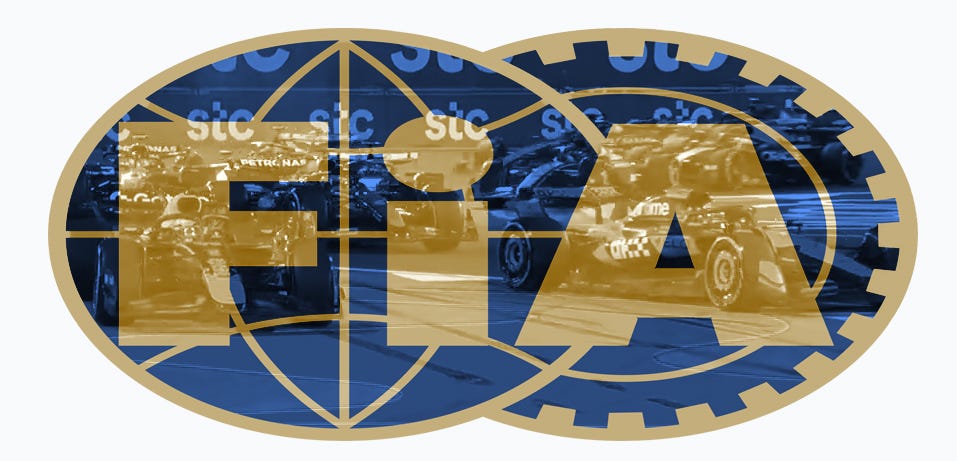Poor Explanation
The biggest issue with the Piastri-Verstappen incident at Jeddah is not the penalty, but its justification.
“There are fair races and ruthless go-getters. Fair races are easy prey for ruthless go-getters,” I wrote after Max Verstappen won his fourth consecutive title last year, keeping the Dutchman in mind, of course. I meant it as a compliment.
The best way to deal with a ruthless go-getter is to be ruthless yourself. Kudos to Oscar Piastri for doing just that against Verstappen at the start of the Saudi Arabian Grand Prix. Both drivers entered the first corner with no intention of yielding. The Dutchman cut Turn 2 to maintain his position, an action that the stewards later deemed deserving of a 5 second penalty.
Where Exactly Is the Apex?
One of the biggest misconceptions about Verstappen is that the “apex rule,” meaning the car ahead at the apex owns the racing line at the exit, was introduced to accommodate his unyielding style. In reality, this rule has been a part of Formula 1 since before he entered the sport. A notable example I often reference is Lewis Hamilton forcing Pastor Maldonado off the track in Valencia back in 2012.
The rule wasn’t invented for Verstappen; he has simply been using and exploiting it to his advantage. But was it in his favor during Turn 1 at Jeddah?
After reviewing the incident multiple times, it seems to me, whether accurately or not, that Piastri's front wing was slightly ahead at the beginning of the apex—specifically, the green-and-white curb—but Verstappen pulled ahead as the apex unfolded.
The latter part was used by Christian Horner to defend his driver. The Dutchman, pressed by journalists during the press conference, declined to share his opinion on the penalty, as he did not want to be at odds with the newly implemented, extremely strict sporting code established by the FIA.
So, depending on which part of the apex is considered “the apex,” this penalty may or may not be correct. I have no issue with whether it’s the beginning, middle, or end, as long as it is applied consistently throughout the season.
In Control?
Right after the incident, Piastri argued on the radio that Verstappen wouldn’t have made the corner, regardless of whether the Aussie was there on the inside or not. He alluded to the fact that drivers must maintain control of their cars.
I thought that the stewards must have agreed with the McLaren driver, and concluded that the only reason Verstappen got ahead at the midpoint of the kerb, was that he carried too much speed into Turn 1 and wouldn’t have made the subsequent right-hander of Turn 2. This, combined with Piastri being ahead at the beginning of the apex, is what I expected to read in the stewards’ decision, because it’s a reasonable and valid justification for the penalty, in my opinion of course.
I can only blame myself for having unrealistic expectations, I guess.
Document 44
After reading the stewards' decision, which can be found here, I’m baffled.
The Stewards reviewed positioning/marshalling system data, video, timing, telemetry and in-car video evidence and determined that car 81 had its front axle at least alongside the mirror of Car 1 prior to and at the apex of corner 1 when trying to overtake Car 1 on the inside. In fact, Car 81 was alongside Car 1 at the apex.
I’m sorry, but the issue is not whether they were alongside, but rather who was ahead. Until last year, this distinction determined who “owns the corner.” Verstappen shoved Norris off the track at COTA—there was no issue with that, as he was ahead at the apex. A week later, he did the same in Mexico, but received a penalty because Norris was ahead this time.
Based on the Driver’s Standards Guidelines, it was therefore Car 81’s corner and he was entitled to be given room.
Well, space was not an issue for Piastri in this case; he had ample room on the inside, I would argue. It was Verstappen who ran out of space. The issue is whether the McLaren driver had the right to take the racing line, or/and whether his Red Bull counterpart was in control of his car.
Maybe I’m too dense, but I don’t get it.
Maybe the aforementioned guidelines will provide me with a clue. Oh, they won’t. That’s because, as ESPN’s Laurence Edmondson noted, they “are not published to the public.”
So, essentially, the stewards can justify their decisions using guidelines that we, the fans, cannot access to form our own opinions on whether a given penalty was correct. Transparent as muddy water.
If I correctly understand the steward's reasoning, the driver on the inside, as long as he is alongside at the apex, owns the corner. Have the Drivers' Standards Guidelines changed? It would be helpful to read them, just to stay informed.


